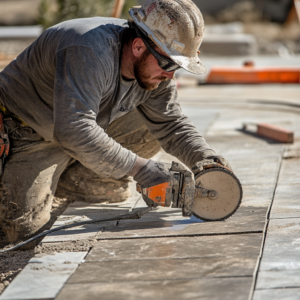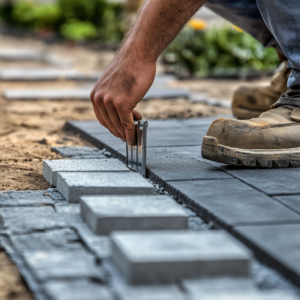Recently, more and more people have been asking us about the effectiveness of rubber patio pavers, or how exactly do they work. So we want to take our time in this article to discuss that subject in depth.
Rubber patio pavers have grown in popularity in recent years. We started seeing them much more frequently, and they started being sought after by many homeowners.
However, anyone who has ever owned or worked with pavers before can notice the big difference they have over more traditional choices. They do come with some advantages, and we will talk about them. But overall, there’s a reason why they are not on the top of the list.
So why is that? What are the pros and cons of rubber patio pavers? Let’s get started!
Jump to:
Rubber Patio Paver: What are They?
Before talking about their effectiveness, we first need to understand what exactly they consist of.
Rubber patio pavers are blocks of recycled rubber molded to mimic the patterns of other famous paver materials, such as concrete and natural stone. Depending on the manufacturer, they can have several different colors, shapes, and sizes.
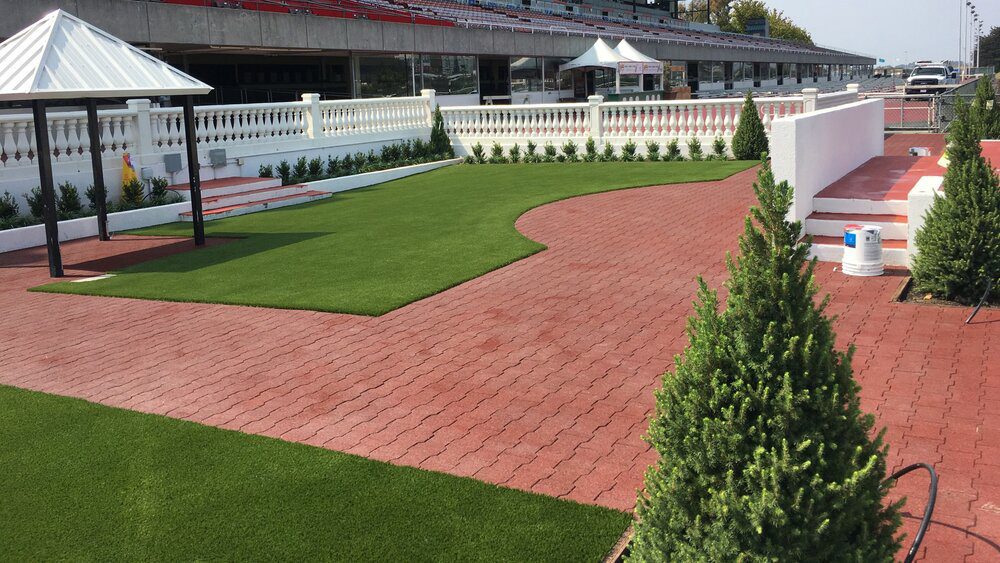
They are created using a combination of recycled car tires, polyurethanes, and dyes. All in all, that makes them a fairly eco-friendly option.
Pros and Cons
Rubber patio pavers are very lightweight and easy to work with. They can be easily replaced when damaged and are very cheap to acquire, costing around $8 – $15 per square foot.
Their biggest advantage is its safety element. Being made of rubber, a much more malleable material than concrete or natural stone, they are very shock absorbent.
Also, they are completely non-slippery, which is a great benefit compared to other options. Usually, especially if used around pools, pavers need to be sealed with a non-slippery finish. Rubber patio pavers don’t have that problem at all.
With that said, though, rubber patio pavers present more disadvantages than advantages. While they can be a good and safe choice for a temporary installation – because they don’t last very long – in areas of heavy traffic or much foot movement, rubber pavers quickly get run over and start cracking and chipping away.
This is their biggest disadvantage.
Also, the appearance of rubber patio pavers has never been a strong point, to begin with. They are known for not even coming close to the visual quality of the most traditional options – and when they start getting damaged, things get even worse.
And they quickly get damaged within months after being installed. After a year or so, homeowners are forced to replace them – not only because of their visual discrepancy but also because of all the loose chips and bits, they can become a big safety hazard for kids.
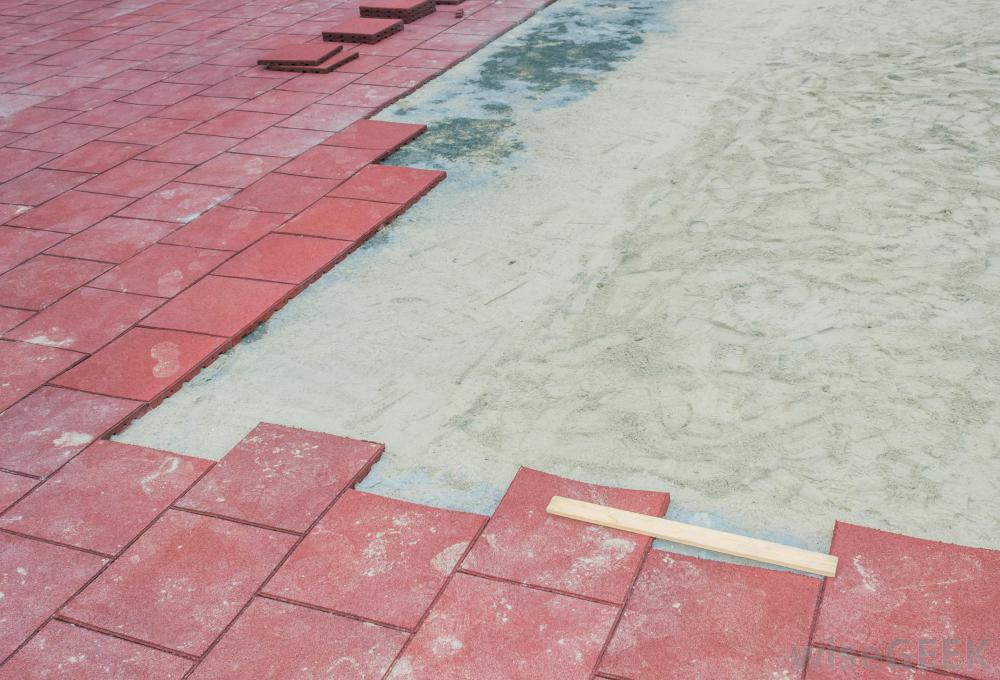
Rubber Patio Pavers and Dry Installations
One of the biggest advantages of using pavers is that they can be used in what we call a dry installation. These types of installations are designed using a road base, a layer of sand upon which the pavers are placed, and polymeric sand, which is used as a bonding agent for the pavers.
This structure becomes a strong “net” that adapts and distributes the weight equally among its strong individual pieces – the pavers themselves. The thing about rubber patio pavers is that they cannot be installed like that.
They are specifically designed to be settled over concrete in combination with construction adhesive. In that scenario, they can work very well, but having that as a technical limitation can be a problem for many homeowners.
Cheap Alternatives to Rubber Patio Pavers
Comparing costs in the hardscape industry is always something tricky to do. Unfortunately, many people still think of pavers in terms of initial costs, like buying a piece of furniture. But ideally, pavers should be treated as a long-term investment.
Many homeowners end up getting attracted by the option that has a cheaper upfront cost, without realizing they are paying for the full price in the long run.
Rubber patio pavers are an excellent example of that; they are much cheaper, even more so than stamped concrete, but they will last a year tops before having to be replaced.
Whereas if you decide to go for more traditional options, like bricks or concrete pavers, you will be investing in something that can last a lifetime. Some of the oldest streets in Italy literally have the same bricks that were put there hundreds of years ago, way back in Ancient Rome times.
So, if we’re talking about the upfront cost, you probably won’t find anything cheaper than rubber pavers. Maybe stamped concrete and pea gravel can be close contestants.
But if you think of hardscape from the long-term perspective, as you should, any other option you choose would pay for itself in a year or so. Concrete pavers, for example, can increase by up to 30% the value of your property.
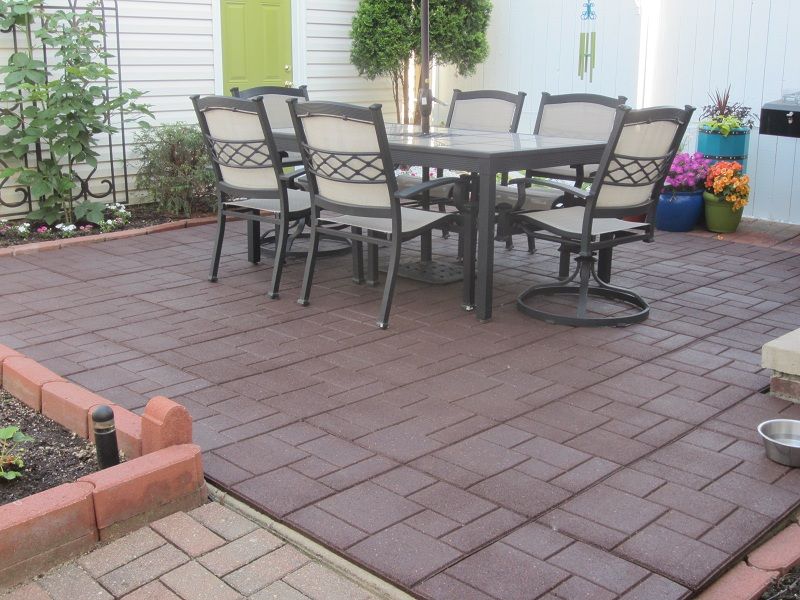
Pros and cons of rubber patio pavers
So, to summarize, let’s give you a complete list of all the pros and cons of rubber patio pavers:
| Pros | Cons |
|---|---|
| Comfort: Rubber patio pavers have a softer and more forgiving surface compared to concrete or brick, making them more comfortable to walk on. | Durability: Rubber patio pavers are not known for their durability. Compared to other choices, they need to be replaced much quicker. |
| Safety: The soft and slip-resistant surface of rubber patio pavers makes them a safer option. They provide good traction and are less likely to cause injuries if someone falls. | Chip and fading: Rubber patio pavers chip much easier, and prolonged exposure to sunlight may cause some color changes over time. |
| Eco-friendly: Many rubber patio pavers are made from recycled materials, such as old tires, making them an environmentally friendly option. | Limited aesthetic options: Rubber patio pavers don’t offer as many design options as some other materials. If you’re looking for a specific color or texture, you might have fewer choices with rubber. |
| Insulation: Rubber has some insulating properties, which means it can help reduce heat absorption, making it more comfortable to walk on during hot weather. | Not ideal for heavy furniture: Rubber patio pavers are not the best choice for areas with heavy furniture, as they may indent or become damaged under the weight. |
Ask for a Professional Opinion
Rubber pavers can be a good choice in some very specific scenarios. The best thing you can do is ask for the professional opinion of a hardscape contractor you can trust in your area.
Hardscape is a complex activity. There are many factors to consider in a project before deciding what is good or bad for it. It would be irresponsible for us to say that rubber pavers are completely bad and should never be used. That’s not the case at all.
But it would also be irresponsible to say that they are as good as the next, equally accessible option. Each set is a different setting that needs to be analyzed by a qualified expert. Depending on your case, rubber patio pavers might fit your project like no other.
We here at JS Brick have performed countless installations throughout our 22 years of activity. We always found some better alternatives, and our clients have always agreed with us. Therefore, find a professional in your area to help you with your project before making any final decisions!
If you’re close to us, next to the Sarasota and Manatee counties, in Florida, we would be happy to help you out. You can contact us any moment at +1 941 586 9140 or email us at [email protected]. We would be glad to hear from you!

